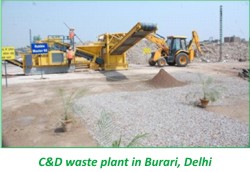|
Construction and Demolition
Waste
With
time, cities have become increasingly vulnerable due to their resource
dependency in the current linear metabolism which puts great pressure on
local resources. One such sector is the construction sector in which
material consumption has grown by more than 1 billion tonnes from the
year 1997 to 2007 (Strategy Paper on Resource Efficiency, 2017). It is
anticipated that this sector will surpass the agricultural sector by
2020 with respect to material consumption. The construction sector
especially in urban areas requires huge volumes of natural resources
such as water, energy and building materials like wood, sand, soil,
stone, metals, most of which have become critical today. Hence, the need
for alternate or secondary resources.
Construction and demolition waste (C&D) has proven to be one of the most useful waste materials which can be re-used and recycled further into a form which is usable in the construction sector for a variety of purposes. The following case study is that of how C&D waste management takes place in Delhi. Delhi has been a pioneer and the first city in India to have its own C&D waste processing facility. A 500 tonne per day (TPD) capacity C&D waste processing plant was set in Burari, New Delhi in 2010. IL&FS Environmental Infrastructure & Services Limited (IL&FS EISL) chose CDE Asia as its technological partner to design, manufacture and supply the C&D waste recycling plant in India. In the processing facility, 2,000 tonnes per day of waste is collected from three designated zones of Delhi - Karolbagh, Sadar and Paharganj. Earlier 27 collection points were identified for waste collection. Later, this was increased to 48. The facility recovers about 97% of the materials from waste for processing. The C&D waste is recycled into aggregates at the facility, which is in turn converted to Ready Mix Concrete (RMC), pavement blocks, kerbstones and concrete bricks. Around 1200 - 1400 bricks are produced from these waste materials within a 8 hour period. These products developed have been tested and verified in laboratories before getting applied in reality. The products are sold as per standard rates of the government and have been made mandatory to be used in construction. An example of the application of these bricks include the construction of Supreme Court office in Pragathi Maidan in Delhi. After the success of the first C&D waste processing plant facility built in Burari, the Delhi government planned to set up more such facilities in different zones of the city to enable shorter distances between the C&D waste generation site and the facility. IL&FS EISL invested considerable amount of effort to promote the second unit of C&D waste recycling in East Delhi at Shastri Park. The plant facility at Shastri park has a capacity of 500 tonnes per day and was commissioned in October 2015. SDMC (South Delhi Municipal Corporation) has also proposed a plant at the Gummanhera site of Najafgarh region.
Although these PPP models have considerably
worked in both the cities of Delhi and Ahmedabad, the sector faces many
challenges, mostly at the ULB level according to NITI Aayog. There needs
to be a constant push to promote the utilisation of recycled products
through different channels including public procurement, development of
standards and certification, green rating, quality assurance, GST
rebates. This multi-faced facility in collaboration with a wide range of
stakeholders needs to be sustained for a certain period of time until a
viable market for recycled products develops in the country.
■
Aishwarya Varadharajan |
